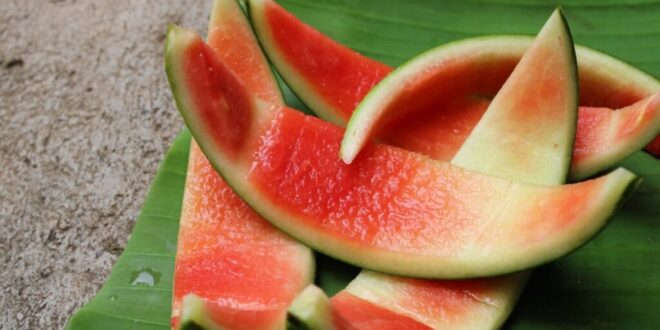Watermelon rinds are delicious. Credit: enjoy58, Shutterstock
You could be wasting a nutritional gem by throwing away your watermelon rind.
Health experts and viral social media posts are turning this often-overlooked part of the fruit into a trending superfood, packed with fibre, antioxidants, and heart-friendly amino acids – and it’s stirring debate over whether it’s real science or just the latest health hype.
Watermelon rind: hidden health benefits
It’s true that watermelon may be the queen among summer fruits. But the rind might steal the show. Nutritionists have revealed that this crunchy white layer between the fruit and the green skin is bursting with citrulline, vitamin C, insoluble fibre, and even phosphorus – nutrients that support heart health, bowel function, and muscle recovery.
Sherry Gray, registered dietitian at the University of California Davis, stated that in some ways, meat is more nutritious. Verywell Health. “The rind is very nutritious because it has unusual properties.”
Julie Stefanski is a spokesperson of the Academy of Nutrition and Dietetics. She told Verywell the rind was “very rich in fibre,” something that is often lacking in the modern diet.
Citrulline: Why it is good for your health
Citrulline is a known amino acid that improves circulation and enhances exercise performance.
“One cup of watermelon has about 250–300 mg of citrulline. Gray stated that the rind has about 60% less citrulline as compared to the red flesh.
While you’d need several grams a day to notice major athletic benefits, blending the rind into smoothies or juices could still give your body a useful boost – and social media is full of pre-workout smoothie recipes claiming just that.
Is it safe to eat the rind of a watermelon?
Yes – but with a few precautions. Watermelon experts recommend washing it thoroughly before cutting, because the knife may drag bacteria into the edible part. And go slow at first – the rind is fibrous, so eating too much too quickly can cause bloating, gas, or diarrhoea.
Stefanski warned that “your knife will pass through the outside and into the inside.” Even if you don’t use the rind, make sure to wash it really well.
Also, be careful when leaving out watermelon cut. Food poisoning – especially during the summer – has been linked to watermelon.
How to eat the watermelon rind
The days of throwing rinds in the trash are over. Experts recommend:
- Pickling them like cucumbers to make a tangy snack
- Blending fruit into smoothies to mask flavour
- Sautéing in stir-fries or using in chutneys
- For crunch, add grated cheese to salads
The skin is bitter on the green part, but it tastes like cucumber. It’s a versatile vegetable.
It’s not just a TikTok trend. Nutritionists back it up. It’s worth trying if it can save money, reduce food waste and improve health.
All lifestyle news are available.
View all articles written by Letara Dragghia
 Costa News Spain Breaking News | English News in Spain.
Costa News Spain Breaking News | English News in Spain.





